NISSAN VERSA SEDAN 2017 2.G Manual PDF
Manufacturer: NISSAN, Model Year: 2017, Model line: VERSA SEDAN, Model: NISSAN VERSA SEDAN 2017 2.GPages: 404, PDF Size: 4.02 MB
Page 71 of 404
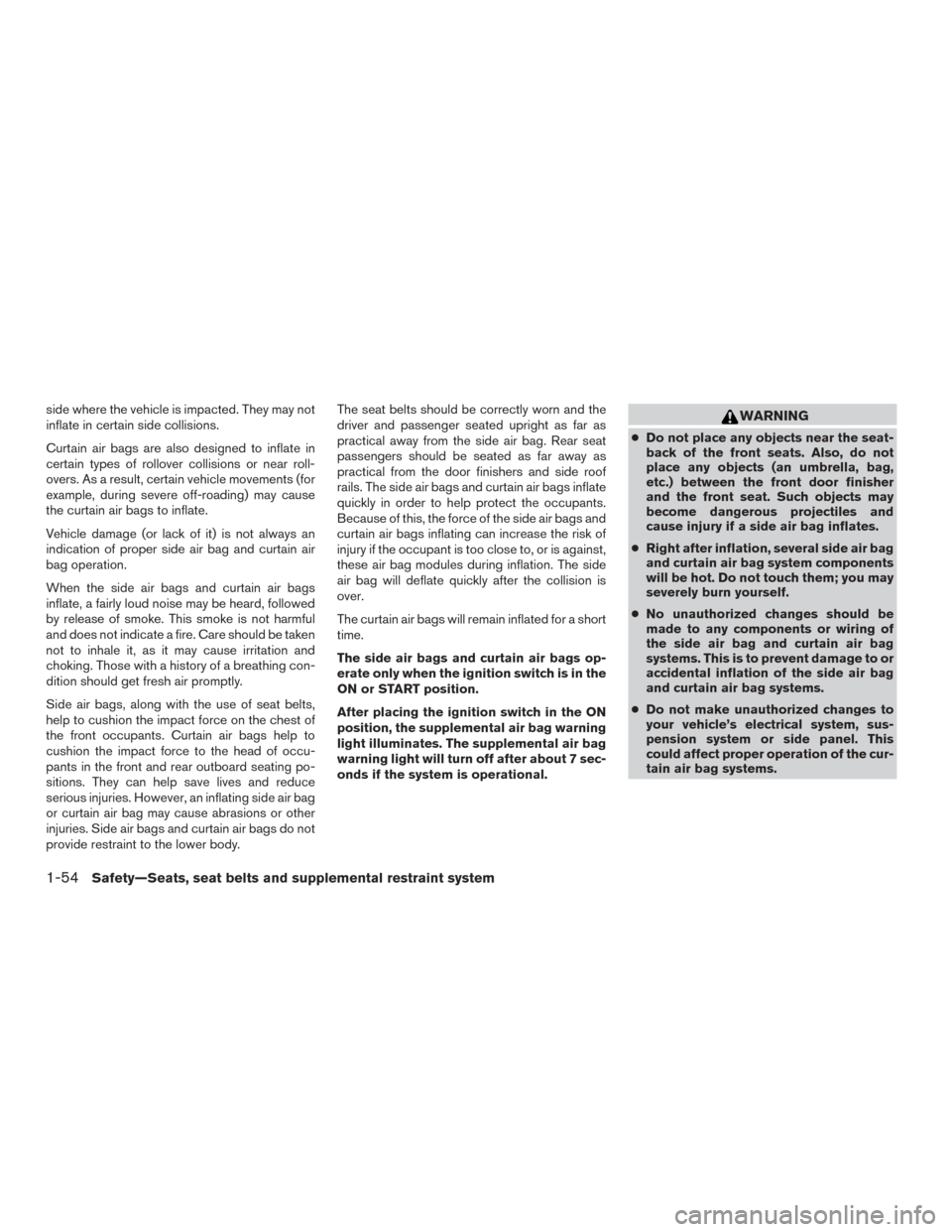
side where the vehicle is impacted. They may not
inflate in certain side collisions.
Curtain air bags are also designed to inflate in
certain types of rollover collisions or near roll-
overs. As a result, certain vehicle movements (for
example, during severe off-roading) may cause
the curtain air bags to inflate.
Vehicle damage (or lack of it) is not always an
indication of proper side air bag and curtain air
bag operation.
When the side air bags and curtain air bags
inflate, a fairly loud noise may be heard, followed
by release of smoke. This smoke is not harmful
and does not indicate a fire. Care should be taken
not to inhale it, as it may cause irritation and
choking. Those with a history of a breathing con-
dition should get fresh air promptly.
Side air bags, along with the use of seat belts,
help to cushion the impact force on the chest of
the front occupants. Curtain air bags help to
cushion the impact force to the head of occu-
pants in the front and rear outboard seating po-
sitions. They can help save lives and reduce
serious injuries. However, an inflating side air bag
or curtain air bag may cause abrasions or other
injuries. Side air bags and curtain air bags do not
provide restraint to the lower body.The seat belts should be correctly worn and the
driver and passenger seated upright as far as
practical away from the side air bag. Rear seat
passengers should be seated as far away as
practical from the door finishers and side roof
rails. The side air bags and curtain air bags inflate
quickly in order to help protect the occupants.
Because of this, the force of the side air bags and
curtain air bags inflating can increase the risk of
injury if the occupant is too close to, or is against,
these air bag modules during inflation. The side
air bag will deflate quickly after the collision is
over.
The curtain air bags will remain inflated for a short
time.
The side air bags and curtain air bags op-
erate only when the ignition switch is in the
ON or START position.
After placing the ignition switch in the ON
position, the supplemental air bag warning
light illuminates. The supplemental air bag
warning light will turn off after about 7 sec-
onds if the system is operational.WARNING
●
Do not place any objects near the seat-
back of the front seats. Also, do not
place any objects (an umbrella, bag,
etc.) between the front door finisher
and the front seat. Such objects may
become dangerous projectiles and
cause injury if a side air bag inflates.
● Right after inflation, several side air bag
and curtain air bag system components
will be hot. Do not touch them; you may
severely burn yourself.
● No unauthorized changes should be
made to any components or wiring of
the side air bag and curtain air bag
systems. This is to prevent damage to or
accidental inflation of the side air bag
and curtain air bag systems.
● Do not make unauthorized changes to
your vehicle’s electrical system, sus-
pension system or side panel. This
could affect proper operation of the cur-
tain air bag systems.
1-54Safety—Seats, seat belts and supplemental restraint system
Page 72 of 404
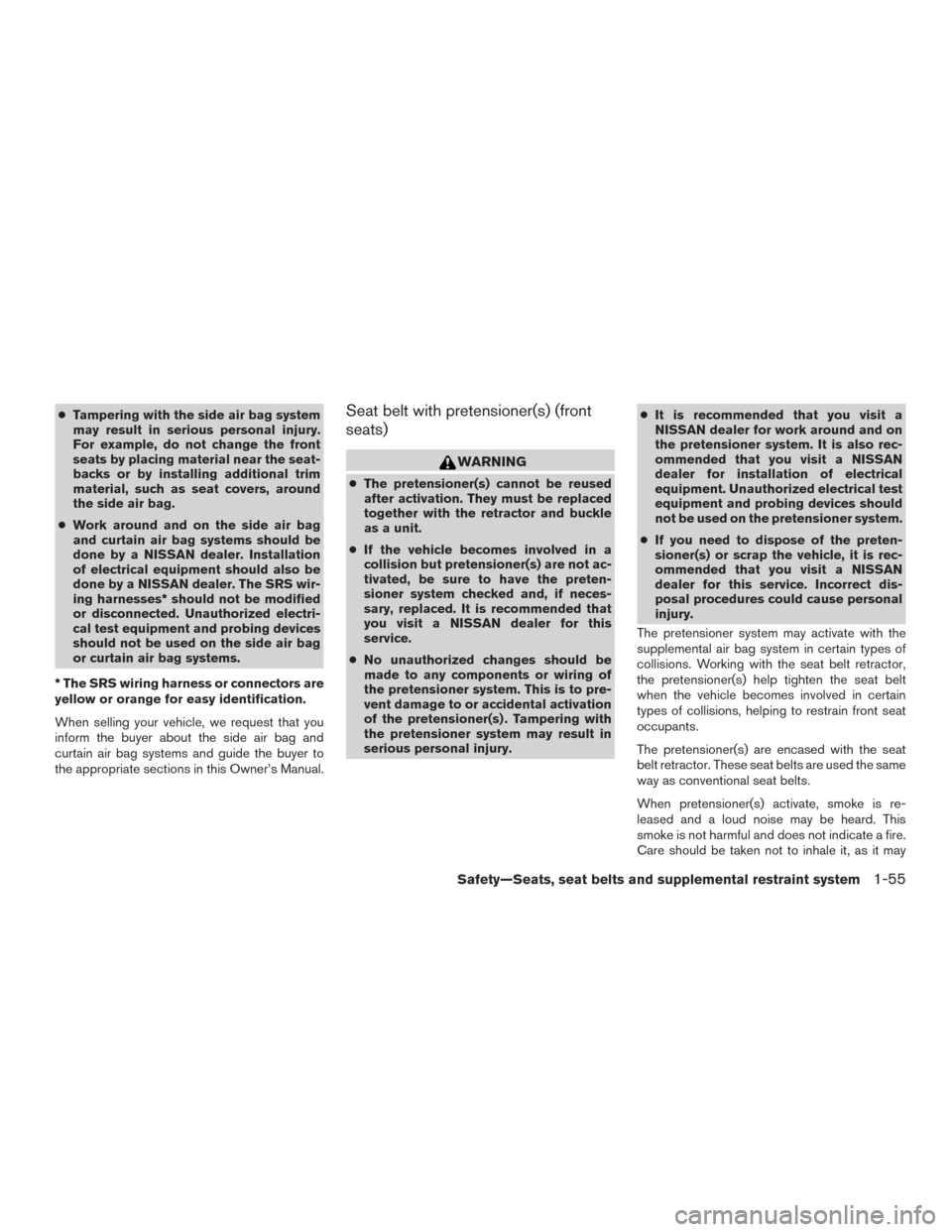
●Tampering with the side air bag system
may result in serious personal injury.
For example, do not change the front
seats by placing material near the seat-
backs or by installing additional trim
material, such as seat covers, around
the side air bag.
● Work around and on the side air bag
and curtain air bag systems should be
done by a NISSAN dealer. Installation
of electrical equipment should also be
done by a NISSAN dealer. The SRS wir-
ing harnesses* should not be modified
or disconnected. Unauthorized electri-
cal test equipment and probing devices
should not be used on the side air bag
or curtain air bag systems.
* The SRS wiring harness or connectors are
yellow or orange for easy identification.
When selling your vehicle, we request that you
inform the buyer about the side air bag and
curtain air bag systems and guide the buyer to
the appropriate sections in this Owner’s Manual.Seat belt with pretensioner(s) (front
seats)
WARNING
● The pretensioner(s) cannot be reused
after activation. They must be replaced
together with the retractor and buckle
as a unit.
● If the vehicle becomes involved in a
collision but pretensioner(s) are not ac-
tivated, be sure to have the preten-
sioner system checked and, if neces-
sary, replaced. It is recommended that
you visit a NISSAN dealer for this
service.
● No unauthorized changes should be
made to any components or wiring of
the pretensioner system. This is to pre-
vent damage to or accidental activation
of the pretensioner(s) . Tampering with
the pretensioner system may result in
serious personal injury. ●
It is recommended that you visit a
NISSAN dealer for work around and on
the pretensioner system. It is also rec-
ommended that you visit a NISSAN
dealer for installation of electrical
equipment. Unauthorized electrical test
equipment and probing devices should
not be used on the pretensioner system.
● If you need to dispose of the preten-
sioner(s) or scrap the vehicle, it is rec-
ommended that you visit a NISSAN
dealer for this service. Incorrect dis-
posal procedures could cause personal
injury.
The pretensioner system may activate with the
supplemental air bag system in certain types of
collisions. Working with the seat belt retractor,
the pretensioner(s) help tighten the seat belt
when the vehicle becomes involved in certain
types of collisions, helping to restrain front seat
occupants.
The pretensioner(s) are encased with the seat
belt retractor. These seat belts are used the same
way as conventional seat belts.
When pretensioner(s) activate, smoke is re-
leased and a loud noise may be heard. This
smoke is not harmful and does not indicate a fire.
Care should be taken not to inhale it, as it may
Safety—Seats, seat belts and supplemental restraint system1-55
Page 73 of 404
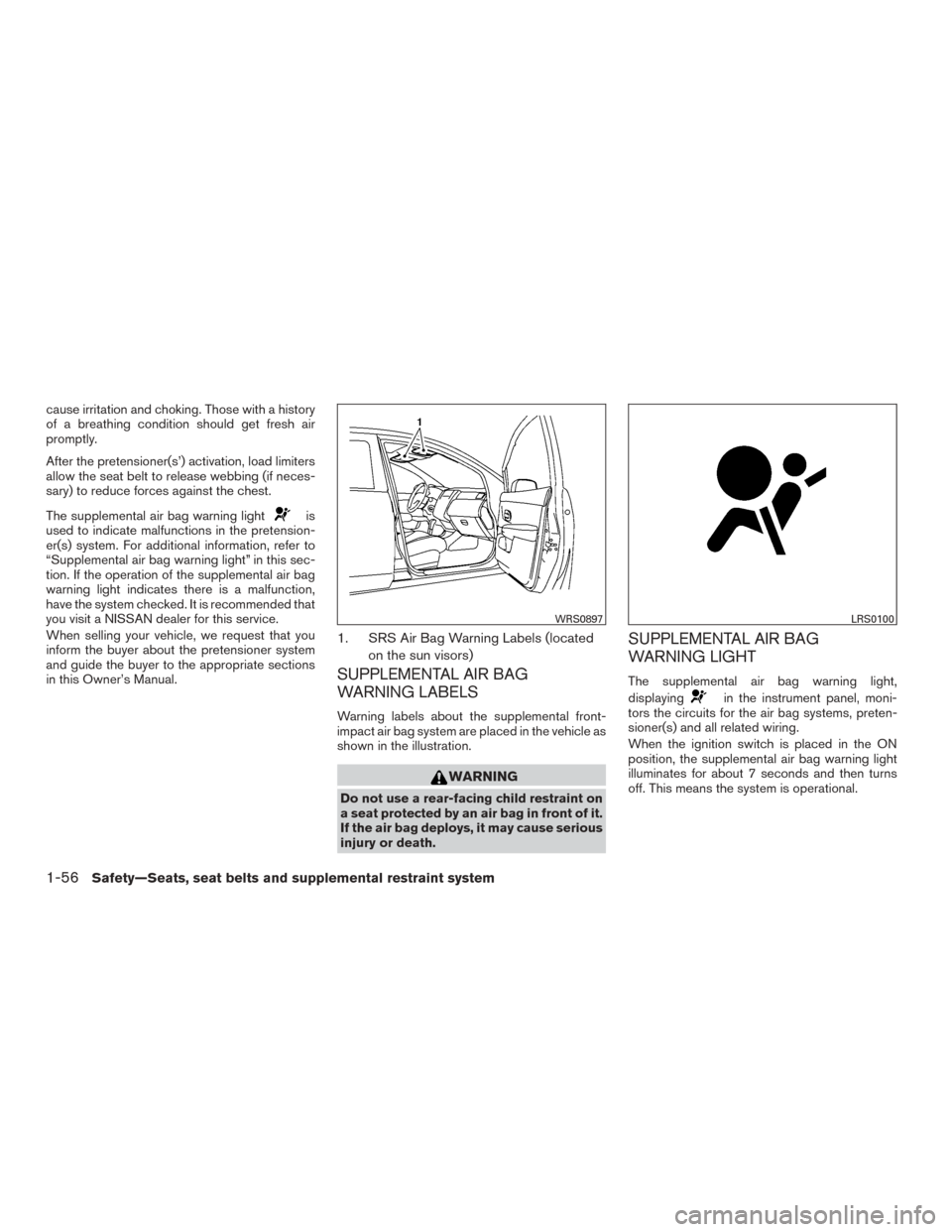
cause irritation and choking. Those with a history
of a breathing condition should get fresh air
promptly.
After the pretensioner(s’) activation, load limiters
allow the seat belt to release webbing (if neces-
sary) to reduce forces against the chest.
The supplemental air bag warning light
is
used to indicate malfunctions in the pretension-
er(s) system. For additional information, refer to
“Supplemental air bag warning light” in this sec-
tion. If the operation of the supplemental air bag
warning light indicates there is a malfunction,
have the system checked. It is recommended that
you visit a NISSAN dealer for this service.
When selling your vehicle, we request that you
inform the buyer about the pretensioner system
and guide the buyer to the appropriate sections
in this Owner’s Manual.
1. SRS Air Bag Warning Labels (located
on the sun visors)
SUPPLEMENTAL AIR BAG
WARNING LABELS
Warning labels about the supplemental front-
impact air bag system are placed in the vehicle as
shown in the illustration.
WARNING
Do not use a rear-facing child restraint on
a seat protected by an air bag in front of it.
If the air bag deploys, it may cause serious
injury or death.
SUPPLEMENTAL AIR BAG
WARNING LIGHT
The supplemental air bag warning light,
displaying
in the instrument panel, moni-
tors the circuits for the air bag systems, preten-
sioner(s) and all related wiring.
When the ignition switch is placed in the ON
position, the supplemental air bag warning light
illuminates for about 7 seconds and then turns
off. This means the system is operational.
WRS0897LRS0100
1-56Safety—Seats, seat belts and supplemental restraint system
Page 74 of 404
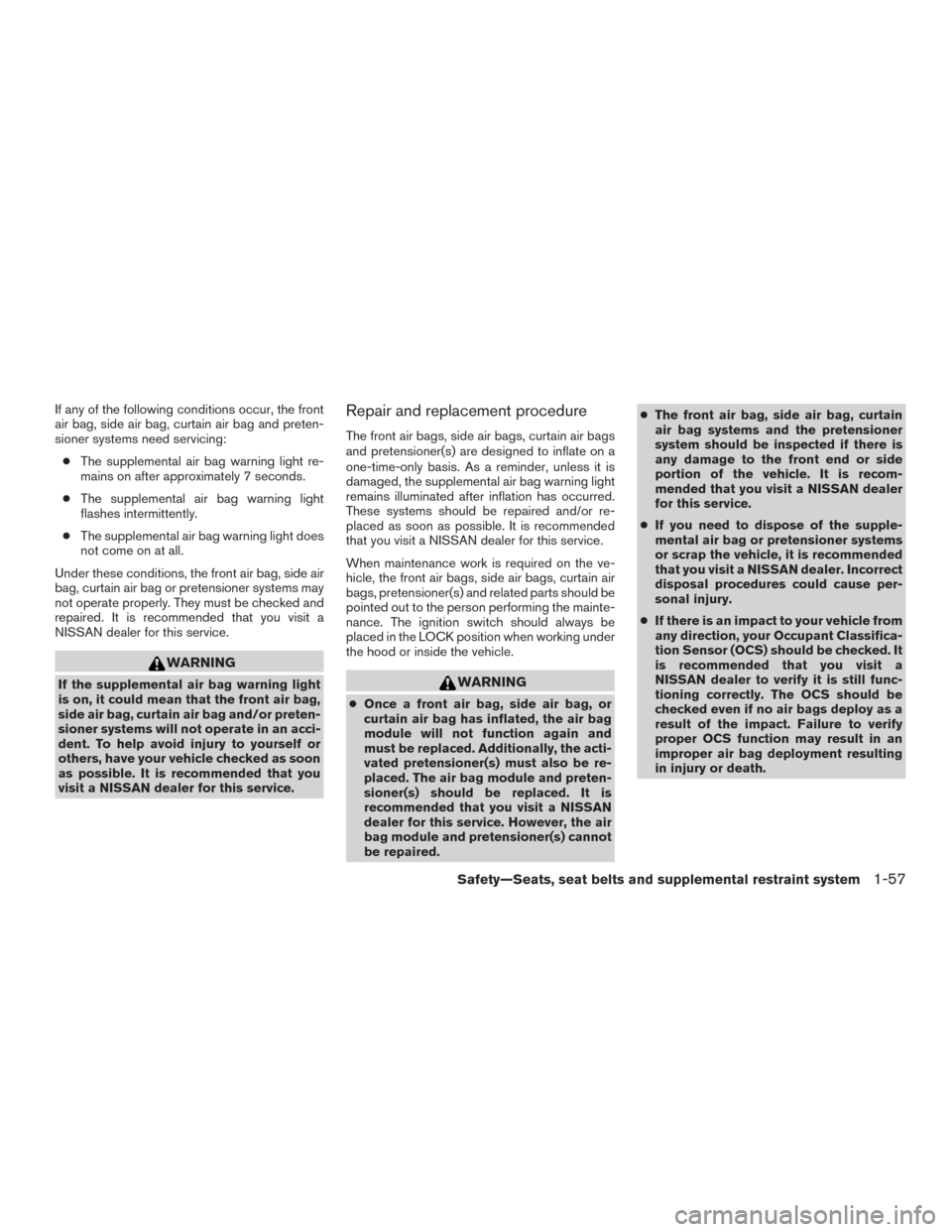
If any of the following conditions occur, the front
air bag, side air bag, curtain air bag and preten-
sioner systems need servicing:● The supplemental air bag warning light re-
mains on after approximately 7 seconds.
● The supplemental air bag warning light
flashes intermittently.
● The supplemental air bag warning light does
not come on at all.
Under these conditions, the front air bag, side air
bag, curtain air bag or pretensioner systems may
not operate properly. They must be checked and
repaired. It is recommended that you visit a
NISSAN dealer for this service.
WARNING
If the supplemental air bag warning light
is on, it could mean that the front air bag,
side air bag, curtain air bag and/or preten-
sioner systems will not operate in an acci-
dent. To help avoid injury to yourself or
others, have your vehicle checked as soon
as possible. It is recommended that you
visit a NISSAN dealer for this service.
Repair and replacement procedure
The front air bags, side air bags, curtain air bags
and pretensioner(s) are designed to inflate on a
one-time-only basis. As a reminder, unless it is
damaged, the supplemental air bag warning light
remains illuminated after inflation has occurred.
These systems should be repaired and/or re-
placed as soon as possible. It is recommended
that you visit a NISSAN dealer for this service.
When maintenance work is required on the ve-
hicle, the front air bags, side air bags, curtain air
bags, pretensioner(s) and related parts should be
pointed out to the person performing the mainte-
nance. The ignition switch should always be
placed in the LOCK position when working under
the hood or inside the vehicle.
WARNING
● Once a front air bag, side air bag, or
curtain air bag has inflated, the air bag
module will not function again and
must be replaced. Additionally, the acti-
vated pretensioner(s) must also be re-
placed. The air bag module and preten-
sioner(s) should be replaced. It is
recommended that you visit a NISSAN
dealer for this service. However, the air
bag module and pretensioner(s) cannot
be repaired. ●
The front air bag, side air bag, curtain
air bag systems and the pretensioner
system should be inspected if there is
any damage to the front end or side
portion of the vehicle. It is recom-
mended that you visit a NISSAN dealer
for this service.
● If you need to dispose of the supple-
mental air bag or pretensioner systems
or scrap the vehicle, it is recommended
that you visit a NISSAN dealer. Incorrect
disposal procedures could cause per-
sonal injury.
● If there is an impact to your vehicle from
any direction, your Occupant Classifica-
tion Sensor (OCS) should be checked. It
is recommended that you visit a
NISSAN dealer to verify it is still func-
tioning correctly. The OCS should be
checked even if no air bags deploy as a
result of the impact. Failure to verify
proper OCS function may result in an
improper air bag deployment resulting
in injury or death.
Safety—Seats, seat belts and supplemental restraint system1-57
Page 75 of 404

MEMO
1-58Safety—Seats, seat belts and supplemental restraint system
Page 76 of 404
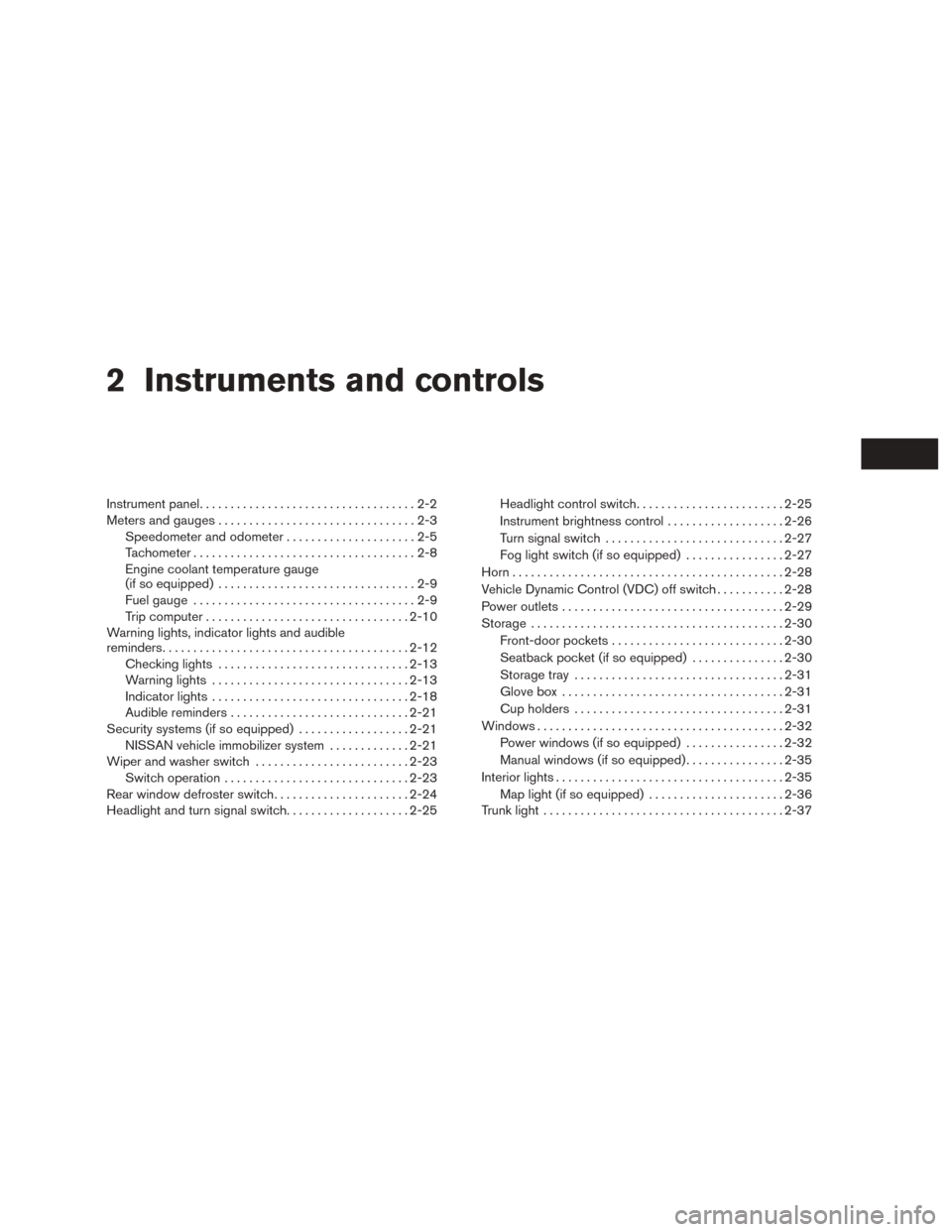
2 Instruments and controls
Instrument panel...................................2-2
Meters and gauges ................................2-3
Speedometer and odometer .....................2-5
Tachometer ....................................2-8
Engine coolant temperature gauge
(if so equipped) ................................2-9
Fuel gauge ....................................2-9
Trip computer ................................. 2-10
Warning lights, indicator lights and audible
reminders ........................................ 2-12
Checking lights ............................... 2-13
Warning lights ................................ 2-13
Indicator lights ................................ 2-18
Audible reminders ............................. 2-21
Security systems (if so equipped) ..................2-21
NISSAN vehicle immobilizer system .............2-21
Wiper and washer switch ......................... 2-23
Switch operation .............................. 2-23
Rear window defroster switch ......................2-24
Headlight and turn signal switch ....................2-25Headlight control switch
........................ 2-25
Instrument brightness control ...................2-26
Turn signal switch ............................. 2-27
Fog light switch (if so equipped) ................2-27
Horn ............................................ 2-28
Vehicle Dynamic Control (VDC) off switch ...........2-28
Power outlets .................................... 2-29
Storage ......................................... 2-30
Front-door pockets ............................ 2-30
Seatback pocket (if so equipped) . . .............2-30
Storage tray .................................. 2-31
Glove box .................................... 2-31
Cup holders .................................. 2-31
Windows ........................................ 2-32
Power windows (if so equipped) ................2-32
Manual windows (if so equipped) ................2-35
Interior lights ..................................... 2-35
Map light (if so equipped) ......................2-36
T runk
light ....................................... 2-37
Page 77 of 404
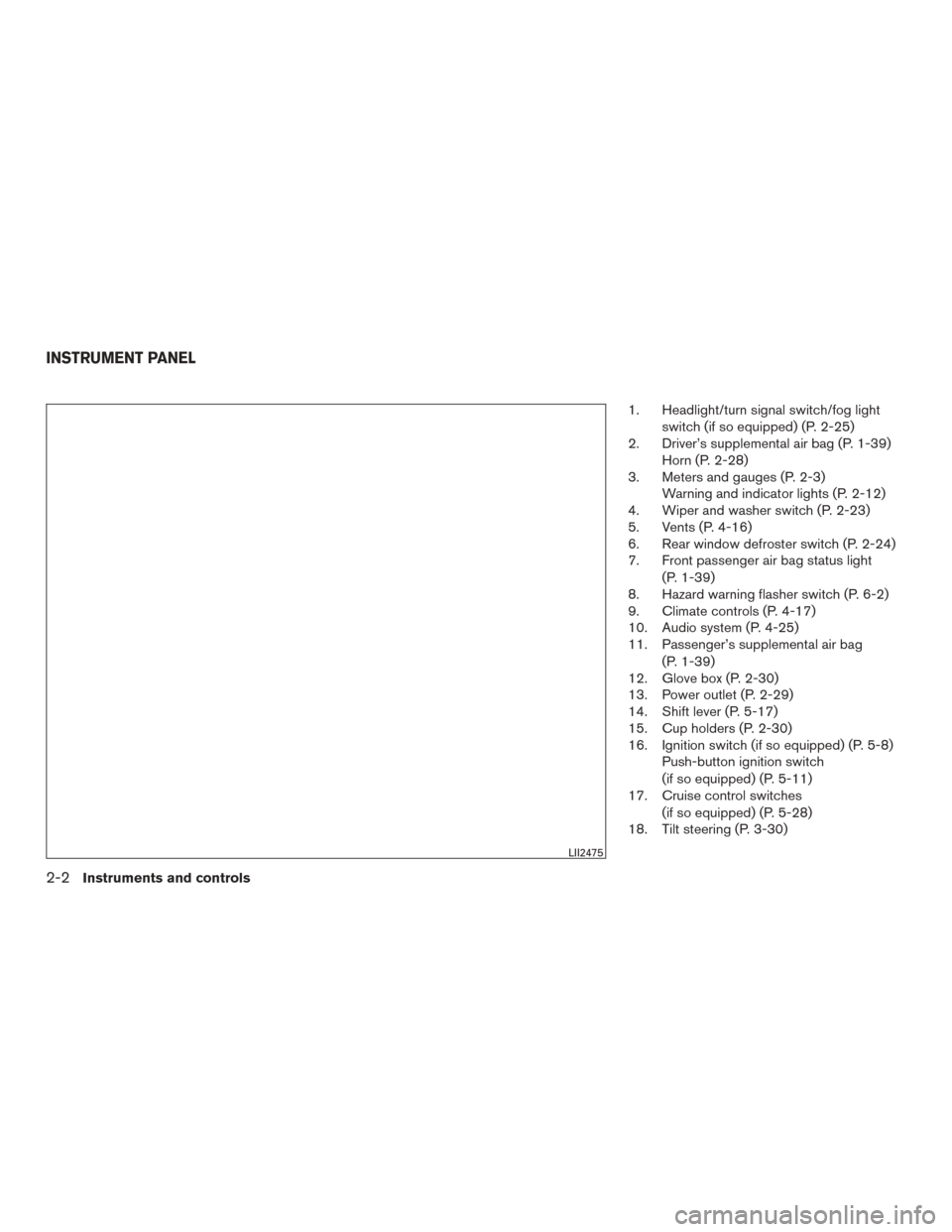
1. Headlight/turn signal switch/fog lightswitch (if so equipped) (P. 2-25)
2. Driver’s supplemental air bag (P. 1-39) Horn (P. 2-28)
3. Meters and gauges (P. 2-3) Warning and indicator lights (P. 2-12)
4. Wiper and washer switch (P. 2-23)
5. Vents (P. 4-16)
6. Rear window defroster switch (P. 2-24)
7. Front passenger air bag status light
(P. 1-39)
8. Hazard warning flasher switch (P. 6-2)
9. Climate controls (P. 4-17)
10. Audio system (P. 4-25)
11. Passenger’s supplemental air bag
(P. 1-39)
12. Glove box (P. 2-30)
13. Power outlet (P. 2-29)
14. Shift lever (P. 5-17)
15. Cup holders (P. 2-30)
16. Ignition switch (if so equipped) (P. 5-8) Push-button ignition switch
(if so equipped) (P. 5-11)
17. Cruise control switches
(if so equipped) (P. 5-28)
18. Tilt steering (P. 3-30)
LII2475
INSTRUMENT PANEL
2-2Instruments and controls
Page 78 of 404
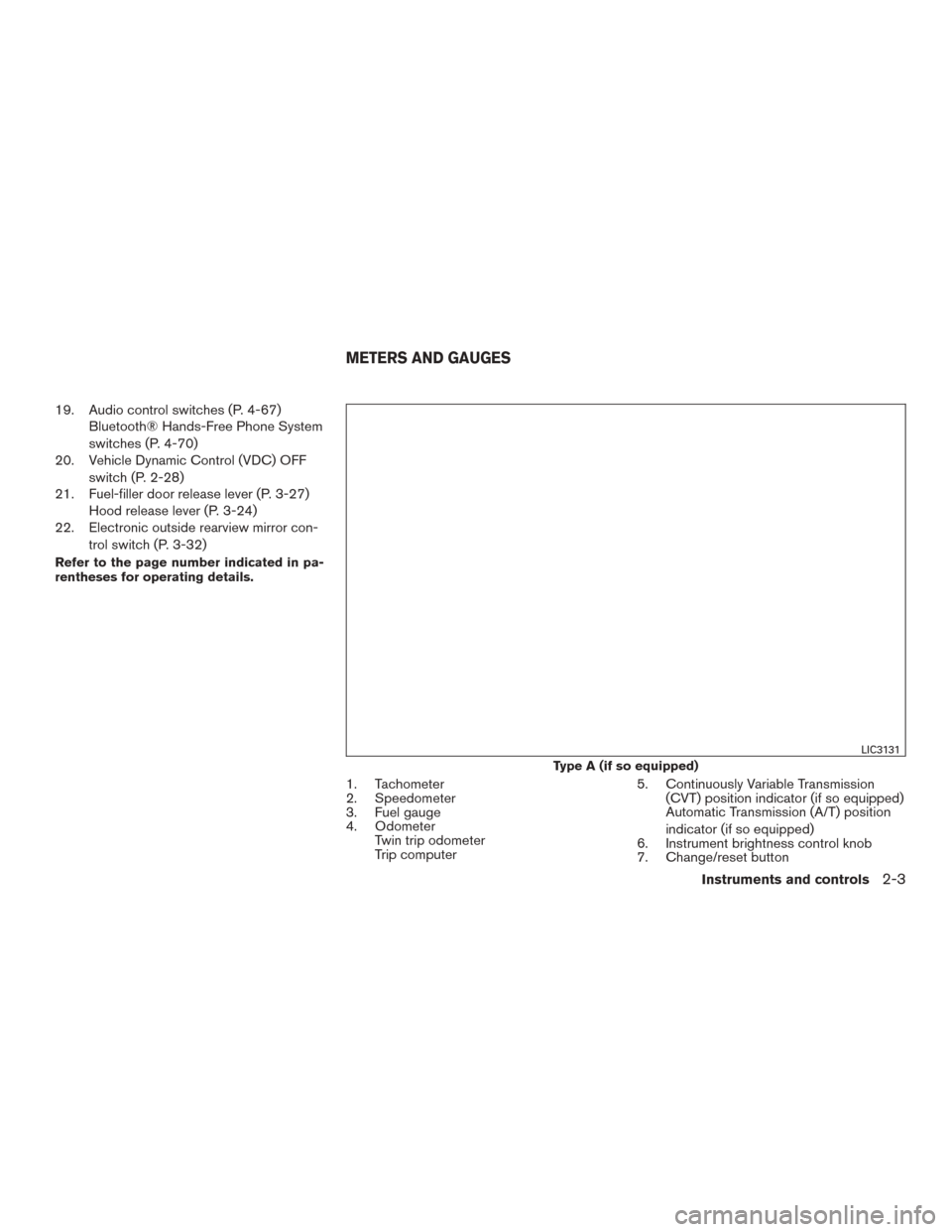
19. Audio control switches (P. 4-67)Bluetooth® Hands-Free Phone System
switches (P. 4-70)
20. Vehicle Dynamic Control (VDC) OFF
switch (P. 2-28)
21. Fuel-filler door release lever (P. 3-27) Hood release lever (P. 3-24)
22. Electronic outside rearview mirror con-
trol switch (P. 3-32)
Refer to the page number indicated in pa-
rentheses for operating details.
1. Tachometer
2. Speedometer
3. Fuel gauge
4. OdometerTwin trip odometer
Trip computer 5. Continuously Variable Transmission
(CVT) position indicator (if so equipped)
Automatic Transmission (A/T) position
indicator (if so equipped)
6. Instrument brightness control knob
7. Change/reset button
Type A (if so equipped)
LIC3131
METERS AND GAUGES
Instruments and controls2-3
Page 79 of 404
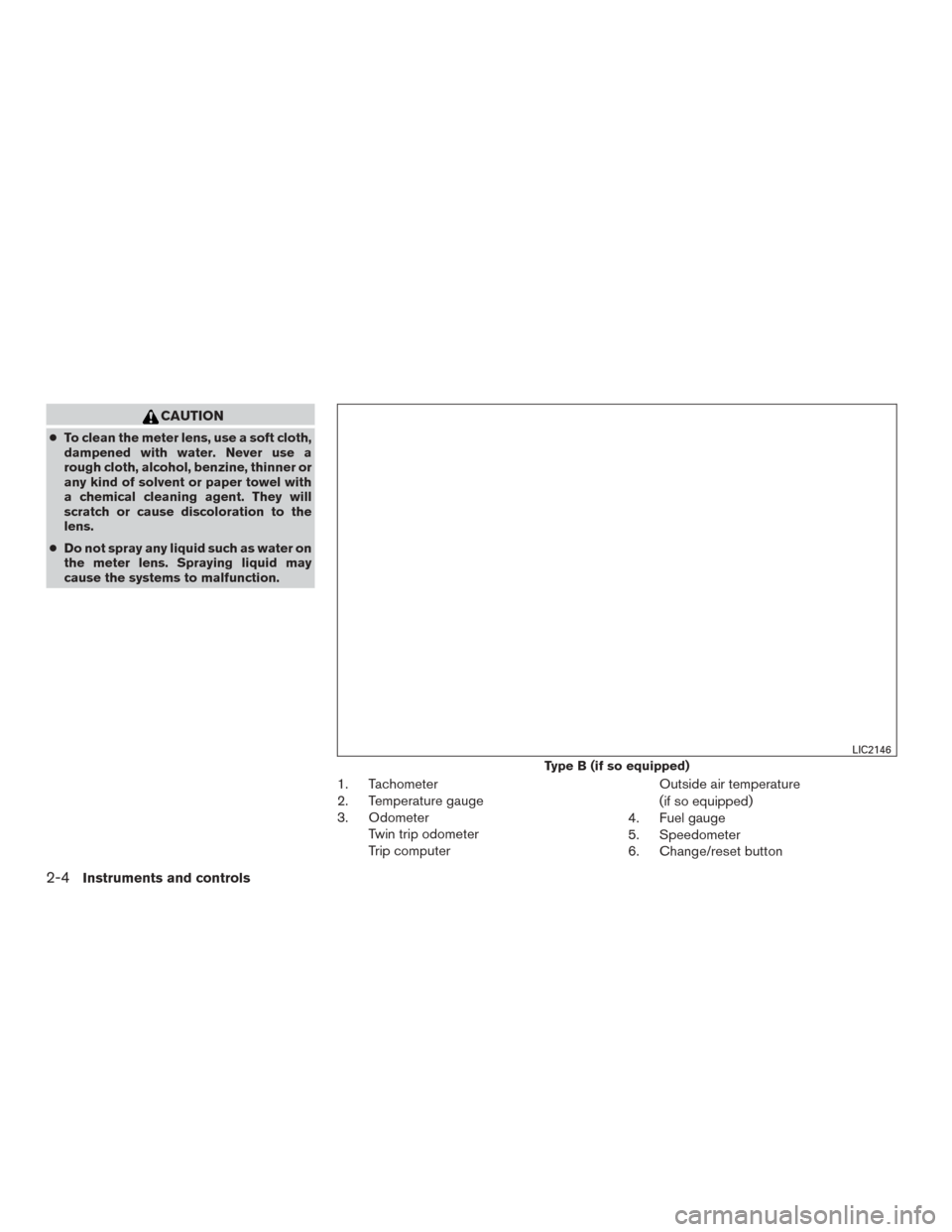
CAUTION
●To clean the meter lens, use a soft cloth,
dampened with water. Never use a
rough cloth, alcohol, benzine, thinner or
any kind of solvent or paper towel with
a chemical cleaning agent. They will
scratch or cause discoloration to the
lens.
● Do not spray any liquid such as water on
the meter lens. Spraying liquid may
cause the systems to malfunction.
1. Tachometer
2. Temperature gauge
3. Odometer
Twin trip odometer
Trip computer Outside air temperature
(if so equipped)
4. Fuel gauge
5. Speedometer
6. Change/reset button
Type B (if so equipped)
LIC2146
2-4Instruments and controls
Page 80 of 404
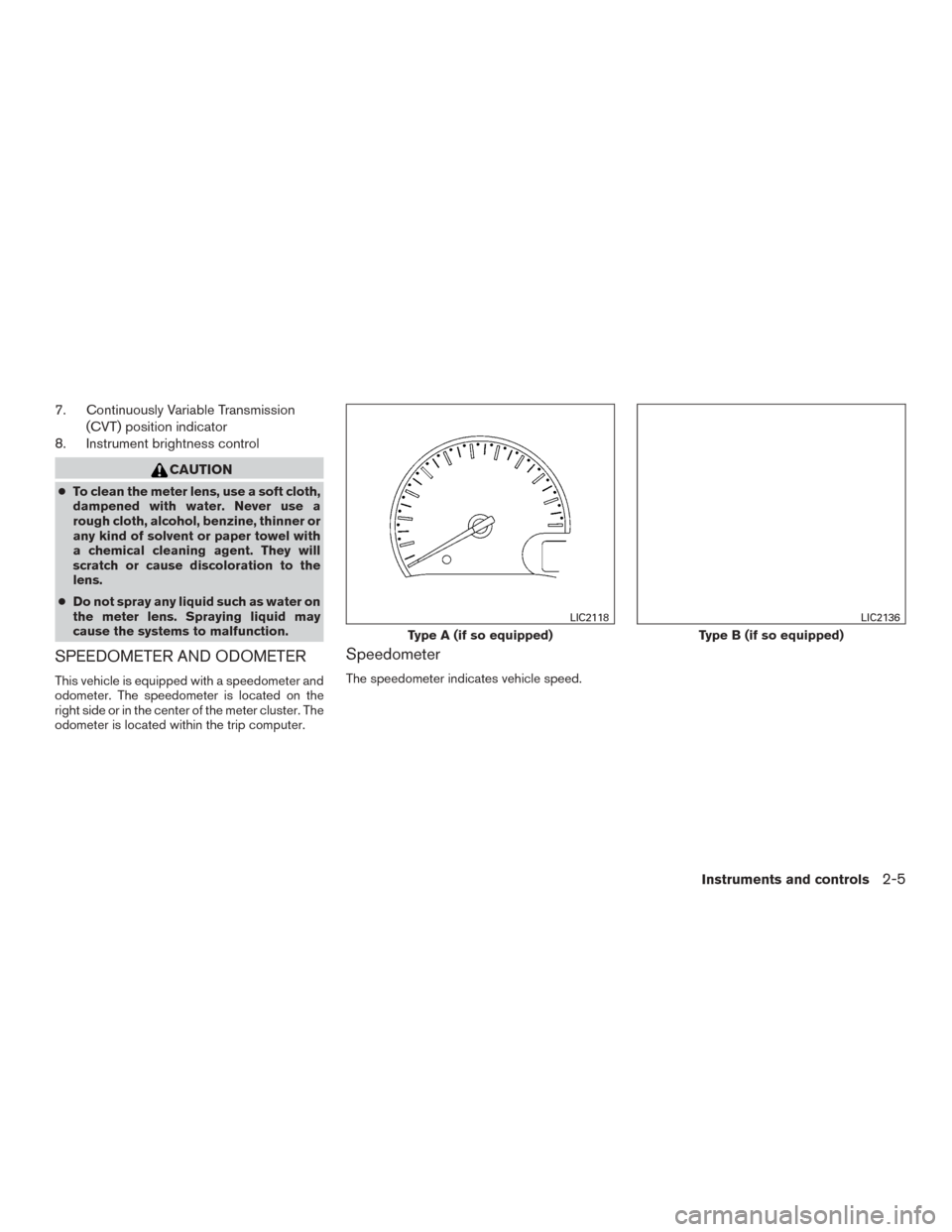
7. Continuously Variable Transmission(CVT) position indicator
8. Instrument brightness control
CAUTION
● To clean the meter lens, use a soft cloth,
dampened with water. Never use a
rough cloth, alcohol, benzine, thinner or
any kind of solvent or paper towel with
a chemical cleaning agent. They will
scratch or cause discoloration to the
lens.
● Do not spray any liquid such as water on
the meter lens. Spraying liquid may
cause the systems to malfunction.
SPEEDOMETER AND ODOMETER
This vehicle is equipped with a speedometer and
odometer. The speedometer is located on the
right side or in the center of the meter cluster. The
odometer is located within the trip computer.
Speedometer
The speedometer indicates vehicle speed.
Type A (if so equipped)
LIC2118
Type B (if so equipped)
LIC2136
Instruments and controls2-5